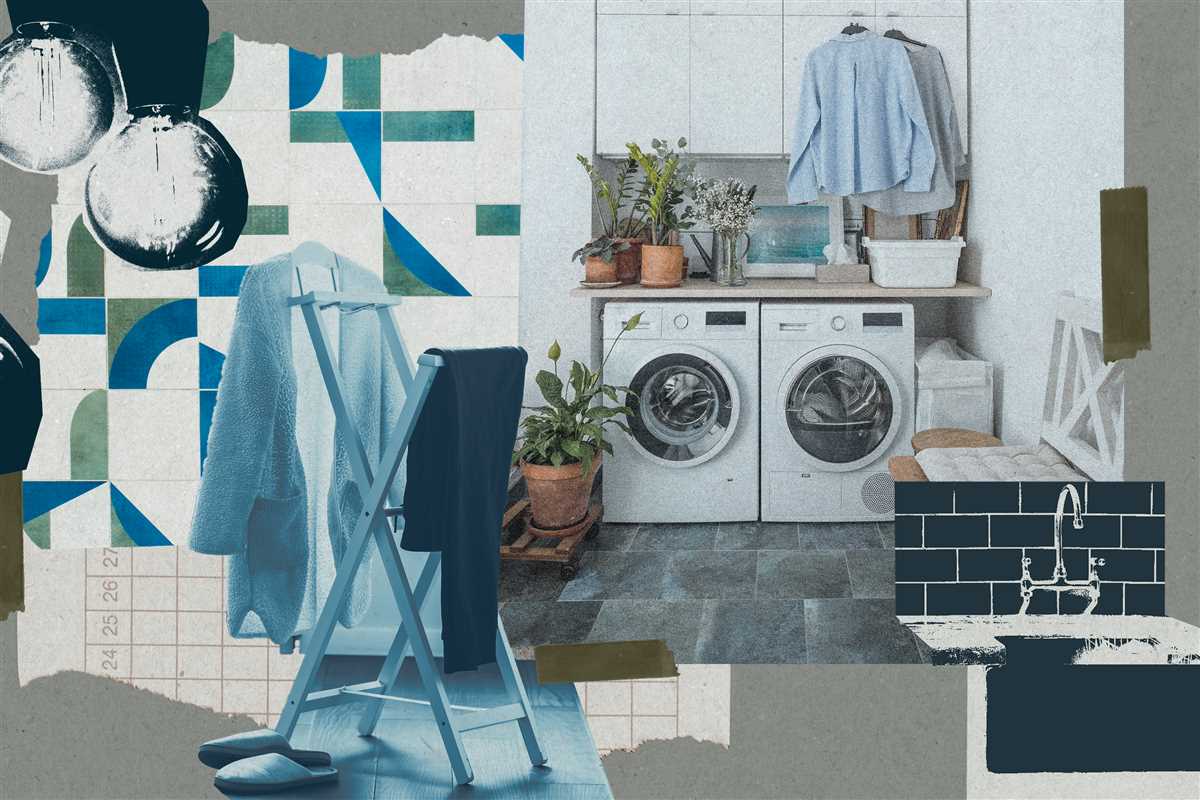




Drying clothes in the bedroom is a common practice for many people. It’s convenient and allows clothes to dry quickly, especially in colder weather or during the winter months. However, there are some concerns and potential drawbacks to consider when drying clothes indoors, specifically in the bedroom.
Moisture and Humidity: One of the main concerns with drying clothes in the bedroom is the increase in moisture levels and humidity. Wet clothes can release a significant amount of moisture into the air, which can lead to mold and mildew growth. This can be particularly problematic in bedrooms, where there may not be adequate ventilation to remove the excess moisture.
Mold and Allergies: The excess moisture from drying clothes indoors can create the perfect environment for mold and allergens to thrive. Mold spores can trigger allergies and respiratory issues, particularly for individuals with asthma or sensitivity to mold. This can be especially concerning in the bedroom, where we spend a significant amount of time and where our immune systems are most vulnerable during sleep.
“Excessive moisture and humidity can create an ideal breeding ground for mold and allergens, which can lead to health issues.”
Energy Efficiency: Drying clothes indoors, especially in the bedroom, can also impact energy efficiency. The moisture released from drying clothes can increase the humidity levels in the room, causing the air conditioner or dehumidifier to work harder to maintain a comfortable atmosphere. This can result in higher energy bills and a less sustainable living environment.
Alternative Solutions: To avoid the potential drawbacks of drying clothes in the bedroom, consider alternative solutions. Utilizing a well-ventilated laundry room or investing in a drying rack or clothesline outside can help minimize moisture and humidity levels indoors. Additionally, using a low-temperature setting on a tumble dryer or utilizing a dehumidifier in the bedroom can also help control moisture levels.
Final Thoughts: While drying clothes in the bedroom may be convenient, it’s important to be aware of the potential issues it can cause. Prioritizing the health and comfort of your living space is key. Consider alternative drying methods and take steps to control moisture levels to ensure a clean and healthy environment for yourself and your family.
Is Drying Clothes in the Bedroom Bad?
Drying clothes in the bedroom is a common practice for many people, especially those who live in small apartments or lack access to outdoor drying space. However, there are several factors to consider before deciding to dry your clothes in the bedroom.
1. Humidity and Moisture

Drying clothes indoors can significantly increase the humidity levels in your bedroom. This can potentially lead to mold growth and dampness-related issues. Mold spores thrive in damp environments, and the excess moisture from drying clothes can contribute to their growth. Moreover, high humidity can also trigger respiratory problems for individuals who are sensitive to mold or suffer from asthma or allergies.
2. Odors
The process of drying clothes releases moisture and odors into the air. By drying clothes in the bedroom, these odors can linger and affect the overall air quality of the room. This can be especially problematic for individuals with respiratory issues or those who are sensitive to strong smells. The combination of moisture and odors can create an unpleasant environment to sleep in.
3. Allergens and Dust Mites
When clothes are hung up to dry, they can collect dust and other allergens present in the bedroom. This can exacerbate allergy symptoms and create an unhealthy sleeping environment. Dust mites, in particular, thrive in warm and humid conditions, making the bedroom an ideal breeding ground if clothes are regularly dried indoors.
4. Fire Hazard
Drying clothes indoors can increase the risk of fire hazards, especially if they are placed near heaters, electrical outlets, or exposed to open flames. It is crucial to ensure proper ventilation and keep a safe distance between drying clothes and potential sources of ignition to prevent accidents.
Alternative Options
While drying clothes in the bedroom may seem convenient, there are alternative options to consider:
- Utilize outdoor drying spaces such as balconies or clotheslines if available.
- Invest in a portable drying rack that can be used in other areas of the home, such as the bathroom or laundry room.
- Consider using a clothes dryer, either a standalone unit or a washer-dryer combo.
- Use a dehumidifier in the bedroom to reduce moisture levels if drying clothes inside is necessary.
Conclusion
Drying clothes in the bedroom can have several negative effects on the indoor environment, including increased humidity, odors, allergens, and fire hazards. Exploring alternative options for drying clothes can help maintain a healthier and safer living space.
Why Drying Clothes in the Bedroom Can Be Harmful
Drying clothes in the bedroom may seem like a convenient solution, but it can actually be harmful to your health and the condition of your home. Here are some reasons why you should avoid drying clothes in the bedroom:
1. Increased Humidity

When clothes are hung to dry in a confined space like a bedroom, they release moisture into the air. This can lead to an increase in humidity levels, which can create a damp and stuffy environment. High humidity can promote the growth of mold, mildew, and dust mites, which can cause allergies and respiratory problems.
2. Poor Air Quality

The moisture released from drying clothes can also contribute to poor air quality in the bedroom. It can cause a musty smell and create an ideal breeding ground for bacteria and other airborne pollutants. Breathing in these contaminants can irritate your respiratory system and worsen existing respiratory conditions.
3. Accelerated Wear and Tear
Drying clothes indoors, especially in a small space like a bedroom, can result in increased wear and tear on your clothes. The lack of proper ventilation can cause clothes to dry slowly, leading to a prolonged exposure to moisture. This can weaken the fabric fibers and result in shrinking, fading, and a shorter lifespan for your clothes.
4. Fire Hazard
If you are using electric drying racks or clotheslines with heated elements, drying clothes in the bedroom can pose a fire hazard. These heating elements can come into contact with flammable materials in the room, such as curtains or bedding, and potentially start a fire. It is always safer to use dedicated and well-ventilated areas for drying clothes.
5. Increased Energy Consumption
Drying clothes indoors requires energy to power electric drying racks or increase the heating in the room. This can result in increased electricity consumption, leading to higher energy bills. By using outdoor drying methods or a dedicated laundry room, you can save energy and reduce your carbon footprint.
Overall, drying clothes in the bedroom can have a negative impact on your health, the condition of your home, and your energy consumption. It is advisable to find alternative drying solutions that promote proper ventilation and maintain good indoor air quality.
Moisture and Mold Concerns
One of the major concerns of drying clothes in the bedroom is the moisture it creates. When clothes dry, they release moisture into the surrounding air. In a confined space like a bedroom, this moisture can build up and create a humid environment.
Excess moisture in the air can lead to a range of problems, with the most common being the growth of mold and mildew. Mold thrives in humid environments and can easily start growing on walls, furniture, and other surfaces in the bedroom.
Mold growth not only looks unsightly but can also have negative health effects. Breathing in mold spores can trigger allergies, respiratory issues, and even asthma attacks in sensitive individuals.
To prevent the buildup of excessive moisture and the growth of mold, it is important to properly ventilate the bedroom. This can be done by opening windows to let fresh air circulate or using a dehumidifier to remove excess moisture from the air.
Additionally, it is recommended to dry clothes in well-ventilated areas such as a laundry room or outside, if possible. This will help to minimize the release of moisture into the bedroom and reduce the risk of mold growth.
If you must dry clothes in the bedroom, consider using a drying rack or clothesline that allows for better airflow around the clothes, which can help them dry faster and reduce the amount of moisture released into the air.
In summary, drying clothes in the bedroom can lead to moisture buildup and the growth of mold and mildew. To prevent these issues, it is important to properly ventilate the bedroom and consider alternative drying locations if possible.
Expert Advice on Drying Clothes
- Avoid drying clothes in the bedroom: While it may be convenient to dry clothes indoors, especially during the colder months, it is generally advised not to dry clothes in the bedroom. This is because drying clothes in an enclosed space can lead to increased humidity, which can promote the growth of mold and mildew. Additionally, the moisture released by drying clothes can contribute to a damp environment and potentially affect air quality.
- Choose a well-ventilated area: Instead of drying clothes in the bedroom, it is recommended to choose a well-ventilated area where moisture can easily dissipate. This can include a laundry room, bathroom with an extractor fan, or a designated outdoor drying area such as a balcony or terrace.
- Use a clothesline or drying rack: When drying clothes indoors, opt for a clothesline or drying rack. These allow for better air circulation and prevent clothes from coming into direct contact with other surfaces, reducing the risk of moisture buildup and potential damage to furniture or walls.
- Avoid overcrowding: It is important not to overcrowd the drying area with too many clothes. Overcrowding can impede airflow, prolong drying time, and increase the chances of moisture remaining trapped in the fabric.
- Utilize natural ventilation: If drying clothes indoors, open windows or doors to allow for natural ventilation. This helps to remove moisture and prevent a buildup of humidity, reducing the risk of mold and mildew growth.
- Check fabric care labels: Always refer to the fabric care labels on your clothes before choosing a drying method. Some delicate or specific materials may require specialized care and should not be dried in certain conditions, such as direct sunlight or high heat.
- Consider using a dehumidifier: If you live in a particularly humid climate or have limited options for drying clothes in well-ventilated areas, using a dehumidifier can help to reduce moisture levels and prevent dampness in the bedroom.
- Regular maintenance and cleaning: Whether you choose to dry clothes in the bedroom or not, it is important to regularly clean and maintain the drying area to prevent the buildup of dust, lint, and other particles that can affect air quality.
Tips for Properly Drying Clothes

1. Use a Clothesline or Drying Rack
One of the best ways to dry clothes is to use a clothesline or drying rack. This allows the clothes to air dry naturally without any additional heat or electricity. Hang the clothes evenly and ensure that they are not overlapping to promote proper air circulation.
2. Hang Clothes in a Well-Ventilated Area
Choose a well-ventilated area to hang your clothes. This could be near an open window or outside on a sunny day. Good ventilation helps in faster evaporation of moisture from the clothes, preventing mold and mildew growth.
3. Space out the Clothes
Avoid overcrowding the clothesline or drying rack. When you hang clothes too close together, they take longer to dry as air cannot circulate freely. Give enough space between each garment to ensure efficient drying.
4. Shake Out and Smooth Clothes
Before hanging them to dry, give your clothes a good shake to remove any wrinkles or stiffness. Smooth them out with your hands to remove any wrinkles or creases. This will help the clothes dry faster and have fewer wrinkles.
5. Rotate Clothes for Even Drying
If you’re drying clothes indoors, make sure to rotate them occasionally. This ensures that all sides of the garment are exposed to air and that they dry evenly. Rotate the clothes every few hours to speed up the drying process.
6. Avoid Drying Clothes in a Humid Room

Try to avoid hanging clothes to dry in a humid room, such as a bathroom. The moisture in the air can prolong the drying time and may lead to a musty smell. If you have no other option, ensure good ventilation by opening a window or using a fan.
7. Use a Fan or Dehumidifier
If you’re drying clothes indoors, using a fan or dehumidifier can help improve air circulation and reduce drying time. Position a fan near the clothes or use a dehumidifier to extract moisture from the air, speeding up the drying process.
8. Avoid Direct Sunlight

While sunlight can help in drying clothes, it can also cause fading and damage to certain fabrics. If you’re drying clothes outside, try to find a shaded area to prevent direct exposure to the sun. This will protect your clothes and extend their lifespan.
9. Dry Similar Fabrics Together
When drying clothes together, group similar fabrics. Fabrics with similar drying times, such as lightweight items or heavy towels, should be hung together. This will help ensure that all clothes dry evenly and no item is under or over-dried.
10. Check for Dryness Before Storing
Before storing your dried clothes, make sure they are completely dry. This will prevent any mold or mildew growth during storage. Feel the clothes to ensure they are cool and dry to the touch.
By following these tips, you can ensure that your clothes dry properly and efficiently, prolonging their lifespan and preventing any damage or musty smells.
FAQ
Is it safe to dry clothes in the bedroom?
Drying clothes in the bedroom can be safe, but it is not recommended. Moisture from damp clothes can increase humidity levels in the room, which can promote the growth of mold and mildew. It can also make the air feel damp and uncomfortable.
Can drying clothes in the bedroom cause health problems?
Yes, drying clothes in the bedroom can potentially cause health problems. The increased humidity levels from the drying clothes can create an environment conducive to the growth of mold and mildew. Breathing in mold spores can trigger allergies, asthma, and other respiratory issues.
What are the alternatives to drying clothes in the bedroom?
There are several alternatives to drying clothes in the bedroom. One option is to use a clothes drying rack or clothesline outside, weather permitting. Another option is to use a tumble dryer, if one is available. If neither of these options is feasible, consider using a dedicated laundry room or airing cupboard.
How can I reduce the moisture when drying clothes indoors?
There are a few ways to reduce moisture when drying clothes indoors. First, ensure there is proper ventilation in the room by opening windows or using a fan. Second, use a dehumidifier to remove excess moisture from the air. Lastly, try to limit the amount of clothes being dried at one time to minimize the moisture being released into the room.
Are there any specific precautions to take when drying clothes indoors?
Yes, there are some precautions to take when drying clothes indoors. Avoid drying clothes directly on radiators or heaters, as this can be a fire hazard. Make sure to clean the lint trap in the tumble dryer regularly to prevent a buildup of lint, which can also be a fire hazard. It’s also important to monitor the humidity levels in the room and take steps to reduce moisture if necessary.
Does drying clothes in the bedroom cause dampness?
Drying clothes in the bedroom can indeed cause dampness. When wet clothes are hung to dry indoors, the moisture from them can escape into the air and increase the humidity levels in the room. This can lead to a damp environment and promote the growth of mold and mildew.
What are the potential health risks of drying clothes in the bedroom?
Drying clothes in the bedroom can pose potential health risks. The increased humidity levels from the drying clothes can create a favorable environment for mold and mildew to grow. Breathing in mold spores can cause allergic reactions, respiratory problems, and worsen existing conditions like asthma. Additionally, dampness in the bedroom can attract dust mites, which can also trigger allergies and asthma.














